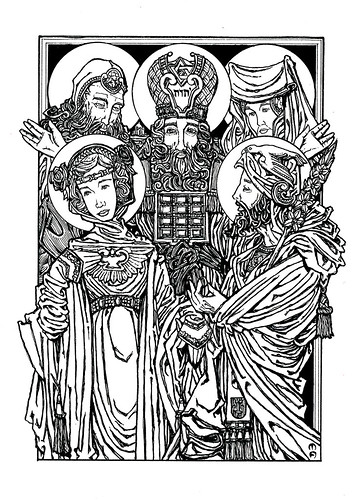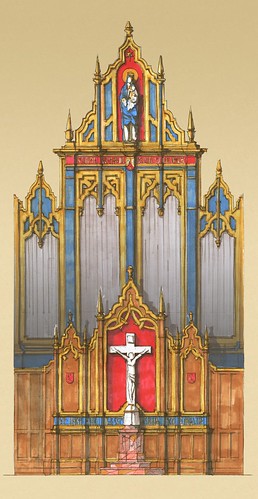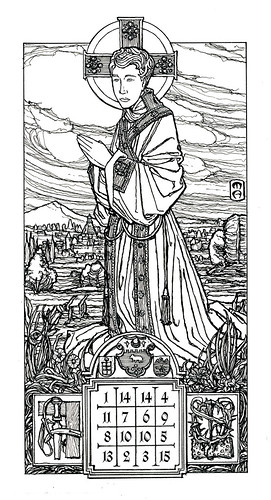Tuesday, July 27
Lawrence Klimecki Interviews Me on Art and Architecture

I was recently interviewed by Deacon Lawrence Klimecki of Gryphon Rampant Studio about my my work in art and liturgical design. Lawrence is a seasoned and very talented graphic artist in his own right, incidentally, with considerable skills in the digital realm as well. Perhaps it is a bit vainglorious to quote from your own interview, but I think both Deacon Klimecki's questions and my answers will be of interest to our readers, if only to generate further thought and discussion on the subject of sacred art. The article is accompanied by examples of my illustrations and designs. Some extracts:
LK: Tell us some more about your work.
MGA: [...] I have a lot of admiration for the medieval model of sacred art, which saw the highest form of art as indelibly religious, and more importantly, tied to both the liturgy and to a received culture. It's one reason I love taking commissions, as it forces me to submit my own interests and preferences to bigger needs and wants. At the same time I'm not trying to turn the clock back. I see myself as engaging in a search-and-rescue operation for much of the remainder of Western Culture that emerged after the Renaissance, which is why I often incorporate elements of later styles--art nouveau, art deco, and even some fairly modern influences, etc.--into my work, though always subject to larger, older traditions. [...]

I also have worked in the field of architecture, sometimes as a member of a firm, sometimes as a designer of church furnishings or as an independent design consultant working in association with an architect. The design consultant creates aesthetic concepts for an interior or exterior that an architect develops in terms of details, structure, and materials. [In addition to my illustration work,] [d]esign consulting and church furnishing design is what I am doing at present, which gives me both the opportunity to focus on the more intellectual and aesthetic aspects of the project while working with an experienced architect with an understanding of structural issues. A local classical firm which I have great relations with has been very helpful thus far along this path, and has offered to be the architect of record when I need one, or when the client hasn't obtained one already.

The problem is art has become something of a closed circle. [...] Essentially, [contemporary artists] say, "Here is my vision," while pounding into our heads that art is a necessity, even if we find it incomprehensible. The odd thing is even the wealthy and au-courant types still love the old masters, and will pay through the nose to support some blockbuster Rembrandt exhibit, but the idea of producing something genuinely new within that tradition simply does not seem to be an option for them in many cases. In an odd way, we've become a very "conservative" culture in terms of actually producing anything. [...]
For me, an artist's job is to follow the rules and conventions set down by received tradition [...] But that doesn't mean he can't work within those conventions to produce something wonderful and beautiful and genuinely new. [...] The central problem is our culture now has very little content--whether in terms of the Faith or even in terms of a central secular story. We have nothing to celebrate, nothing to impart, and thus as a consequence rather than, say, decorating our airports with great allegorical and historical images of flight, or of national virtue, or of the patron saints of the air, we get safely non-controversial art generated by a contest among our schoolchildren, or, at most, something abstract designed carefully not to offend. How are we supposed to get inspired by this? How are we supposed to discover what it means to be the inheritor, as a nation of immigrants, of some of the best cultural traditions of the west and the east as well?

Matthew Alderman. Christ the Youth. Ink, 2010. Private Collection, Kansas.
I think a lot of people find this sort of traditional culture "elitist" or "imperialist," which drives me crazy, as I think often when you get down to it you can find more in common among the traditional cultures of the whole world than the secular universe you have nowadays. [...] Ideally, inclusion within culture would be represented by a series of statues of the great philosophers where you have both Socrates and Confucius, who the Jesuits actually first translated and introduced to the west. Nowadays you just don't have any statues at all. [...]
In architecture, it's a bit different... [...] Most of us who work for classical or traditional firms (quite a few of which exist, and in usual economic conditions, even flourish) have to fight a two-front war between people who assume we're dangerous reactionaries ([Deconstructivist par excellance] Peter Eisenmann once called an audience of classical students, to their face, a bunch of "terrorists"), and those who want something traditional but don't know where to look and thus end up asking Bob's Discount Architects for a Georgian home that appears to have been molded out of plastic. And then, nobody wins, save perhaps Bob. [...]

LK: How is your faith reflected in your work?
MGA: Considering most of my work consists of images of various saints and other religious figures, it's everywhere! There's always a slight tension between when I treat an illustration I'm doing as an exercise in composition, and as an aid to devotion, or to illustrate a particular theological point. I think ideally there should be no such clash, as they ought to be perfectly beautiful and perfectly suitable for their purpose, but working out that relationship can be tricky. I think, though, there is a tendency among purists to want to reduce religious art to a series of flat theological diagrams, which is simply not part of the Western Catholic tradition, which has had room for some limited artistic freedom (admittedly sometimes abused) for six or seven centuries or more. While I could stand to be more systematic, I do pray while I work, and try to ask God and the saint I am drawing to find that balance between composition and intelligibility--I usually ask God to let me do a worthy drawing, but also to have a bit of fun with the subject while I'm at it. And that "fun" also has a component of Faith to it, as it usually manifests itself in the details where I work in another subtler level of symbolism. An ornamental edging of a dress worn by the Virgin might have seashells worked into it, for her title of Stella Maris, for instance. I am reminded of the work of the architect Edwin Lutyens, who once designed light fixtures resembling cardinal's hats for a Jesuit chapel, with the humbling and subtle joke behind then that the red hat was always just a bit above reach for most Jesuits.

In architecture, it's much the same. It's easy to assume a "Catholic" church building will have some saints here, some pointy windows there, maybe a dome--and it often should have these things--but if you don't get the essence right, if you don't adhere to those fundamental underlying codes, it'll look superficial. The way we lay out the sanctuary, the way we plan the location of the altar, or install a baldachin or pulpit, the spatial arrangement of all these is critical in elucidating what we believe. Is the altar and the tabernacle the center or focus of the church, or is it the people? What do these choices tell us about what we believe? It's not enough to simply smear a coating of badly-done "traditional" ornament over a modern shell-though ornament, well-done, is extremely important as well. You just have to get the soul and structure right first. In some places, of course, this may not be possible--in which case you have to use space cleverly and find subtle ways to redirect people's attention to the points that matter.
The full interview can be found here. Images are derived from here and here.












